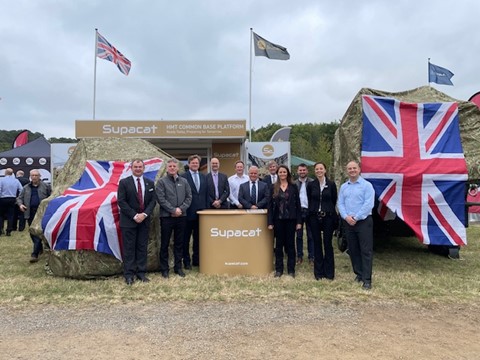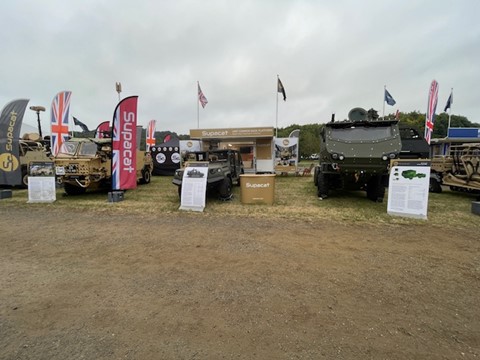
BRITISH DEFENCE MANUFACTURER SUPACAT THIS WEEK TO UNVEIL TACTICAL LIGHT MOBILITY VEHICLE ALONGSIDE THE ARMOURED CLOSED CAB HMT VARIANT AT UK DEFENCE SHOW
Devon-based defence engineering company Supacat is to launch two defence vehicles at DVD2024, taking place at UTAC Millbrook in Bedford 18-19 September. The first of these is a multi-role tactical light mobility vehicle (LMV) for light role and Very High Readiness forces. The second vehicle is a new addition to the High Mobility Transporter (HMT) family, with a 4-person armoured closed cab platform, giving it the flexibility to fulfil a wide range of roles in contested environments in an age when armed forces globally look to reduce numbers of diverse vehicle types by adoption of family fleets and benefit from reduced though life support costs.
The Supacat Light Mobility Vehicle (LMV) combines highly proven ubiquitous Toyota automotive components with a bespoke chassis and battle-tested ‘combat cell’ to deliver a world class high mobility platform with unrivalled versatility and resilience for the battlefield. Over 40 different operational roles have been identified for the four or six-wheel mobility platform, making it ideal for the widest range of light roles on the battlefield, developed especially for use by Very High Readiness troops around the world.
As the British Army places ever greater importance on the mobility and potency of its resources and assets, the LMV has been developed to meet key requirements for strategic mobility, class-leading payload and suitability for internal loading in CH47, C130, A400M and C17. The LMV is manufactured in both 4×4 and 6×6 configurations to suit different roles whilst maintaining extremely high levels of commonality across the family of vehicles – offering a payload of up to 3200 kg, this allows for specialist variants such as Ambulance and Mortar which require significantly higher payload/space requirements, without adding other vehicle types within a deployed fleet and adding to the logistic burden.
Adding simplicity to LMV’s logistic and maintenance demand, it uses already extensively tested Toyota automotive components that have been proven to deliver legendary reliability on all continents and climates globally whilst in full compliance with NATO multifuel policy. The LMV chassis structure has been developed to deliver an optimum mass to strength ratio providing unbeatable payloads in comparison to its competitors. This chassis is a dedicated design rather than a modified COTS chassis, and achieves full STANAG compliance for recovery, tie-down and under sling loads without compromise over a full-service life.
The Combat cell is highly modular allowing numerous configurations for different roles. The base WMIK cell provides a ROPS structure with seating for a crew of 4 (5th percentile Female to 95th percentile Male) in a 2+2 configuration and is equipped with a crew served main weapon (GPMG, HMG, GMG) mounted on a 360° slewing ring and commander’s weapon (GPMG) on a dash mounted swing arm. Space is allocated for customer specified communications/ECM equipment (with 24V DC power) and personal equipment. The rear of the cell forms a load bed for transport of vehicle CES and mission specific equipment. The Combat cell can be fitted with applique blast and ballistic protection kits and with environmental covers to allowing users to balance protection/mobility against changing threat levels in a range of climatic conditions.
Key benefits include:
- Excellent strategic mobility – as well as transportable by fixed wing cargo aircraft for rapid deployment globally, the LMV is able to be loaded internally in CH47 () and underslung from Merlin providing tactical mobility on the battlefield
- Class leading tactical mobility with a power to weight ratio of 32kW/t, long travel front suspension and weight compensating air bag rear suspension with optimised roll geometry for safe on and offroad performance
- Purpose designed chassis provides a high payload and dedicated recovery/under sling points allowing structural optimisation around military requirements to minimise weight and through life support demands
- Dedicated floor structure which can be manufactured from different material grades and thickness to meet a range of protection requirements.
- The Combat Cell provides roll-over protection that exceed applicable commercial and military standards , while meeting the expected UK requirement to accommodate crew within the UK 5th percentile Female to 95th percentile Male occupants size range.
In the development of the LMV, Supacat has engaged with Yorkshire-based Prospeed Motorsports Ltd to develop the LMV’s chassis based on a 4×4 version of their Hiload chassis, as well as developing the floor system, which interfaces between the chassis and Combat Cell.
The Combat Cell has been developed by Armoured Car Systems in Bayern, Germany, providing a modified version of the Combat Cell fitted to its Enok vehicle, thus retaining the modularity and manufacturing process, with geometrical changes to suit the LMV.
Comments the MD of Prospeed, Olly Marshall: “Supacat LMV represents a successful symbiosis of three proven platforms. Leveraging Toyota’s globally renowned and best in class supported COTS platform, militarised in combination with the world’s first and only true 5-tonne 4×4 solution of its kind in HILOAD, provides an unbeatable foundation to build from. An innovative and lightweight armoured floor and ACS combat cell complete what is a lightweight, infinitely adaptable to role and cost-effective light vehicle solution.”
…..
The second system being unveiled at DVD2024 is Supacat’s Armoured Closed Cab (ACC) HMT, which is specifically designed to support UK MOD’s Land Mobility Programme’s fleet reduction to 15 core platform chassis types or less by 2030.
Building on the inherent modularity of the HMT common base platform, this variant provides high levels of crew protection while maintaining sub-system commonality with other HMT variants, including the UK MoD’s Jackal and Coyote. Its closed cab demonstrates the benefits of a modular design, enabling the spiral development of a new capability requirement on an in-service platform.
The 4-person cab provides integral blast and ballistic protection (capability on request), with Human Factors being an important consideration during the development process to provide a safe and comfortable operating environment for 5th percentile Female to 95th percentile Male occupants.
The ACC HMT has been optimised as a mobility platform for complex mission systems, to be crewed by Commander, Driver and two Mission System Operators. The vehicle is compliant with Generic Vehicle Architecture requirements, supporting the electrical and electronic integration of a range of complex Mission Systems. The vehicle has a payload capacity of circa 4500 kg with integrated blast and ballistic armour, with the chassis load bed designed to allow easy physical integration of Mission Systems.
The ACC HMT builds on the HMT’s world class reputation to provide the enhanced protection, payload and mobility required on the modern battlefield. Being able to operate in the same tactical environment as light troops means that organic support can be deployed to the correct place on the battlefield to maximise the safety and effectiveness of troops. Typical roles for the ACC HMT include Ground Based Air Defence, Battle Group Organic Anti-Armour, Ambulance, Recovery Vehicle or Troop carrier.
As a member of the HMT family of vehicles, there are numerous advantages carried forward, including operationally proven reliability and ease of maintenance, a reduced operator and maintainer training burden on introduction to service and use of spare parts common across existing HMT fleets. This ensures that the ACC HMT is able to deliver a very different capability without the need to increase the breadth of the held fleet, reducing the impact on materiel inventory of introducing new capability, whilst supporting the UK MoD’s Land Mobility Programme stated goal of reducing the British Army’s fleet from 30 to 15 core platforms.
Phil Applegarth, director, head of Supacat, said: “Supacat has been privileged to partner with the British Army, and other armies around the world, in the development of what we are confident are the most versatile, rugged and interchangeable military vehicle platforms in the world.
“Our new Light Mobility Vehicle – Tactical (LMV-T)) is the latest edition to the Supacat range, designed specifically with special forces in mind, fulfilling a ‘fly and drive’ capability, with its low weight and compact design enabling tactical loading into transporter aircraft systems whilst maintaining excellent payload capacity.
“Meanwhile, as UK MOD and other defence forces look to rationalise their fleets to achieve great modularity and cost control, our Armoured Closed Cab (ACC) HMT has the potential to revolutionise the army’s ability to sustain operations with much reduced burden on logistics, maintenance and cost. At the heart of our design for both systems has been MOD’s intent under its Land Integrated Strategy to simplify logistics whilst increasing effectiveness. We very much look forward to showcasing both platforms to our customers on Stand OR-24a tomorrow/today.”
